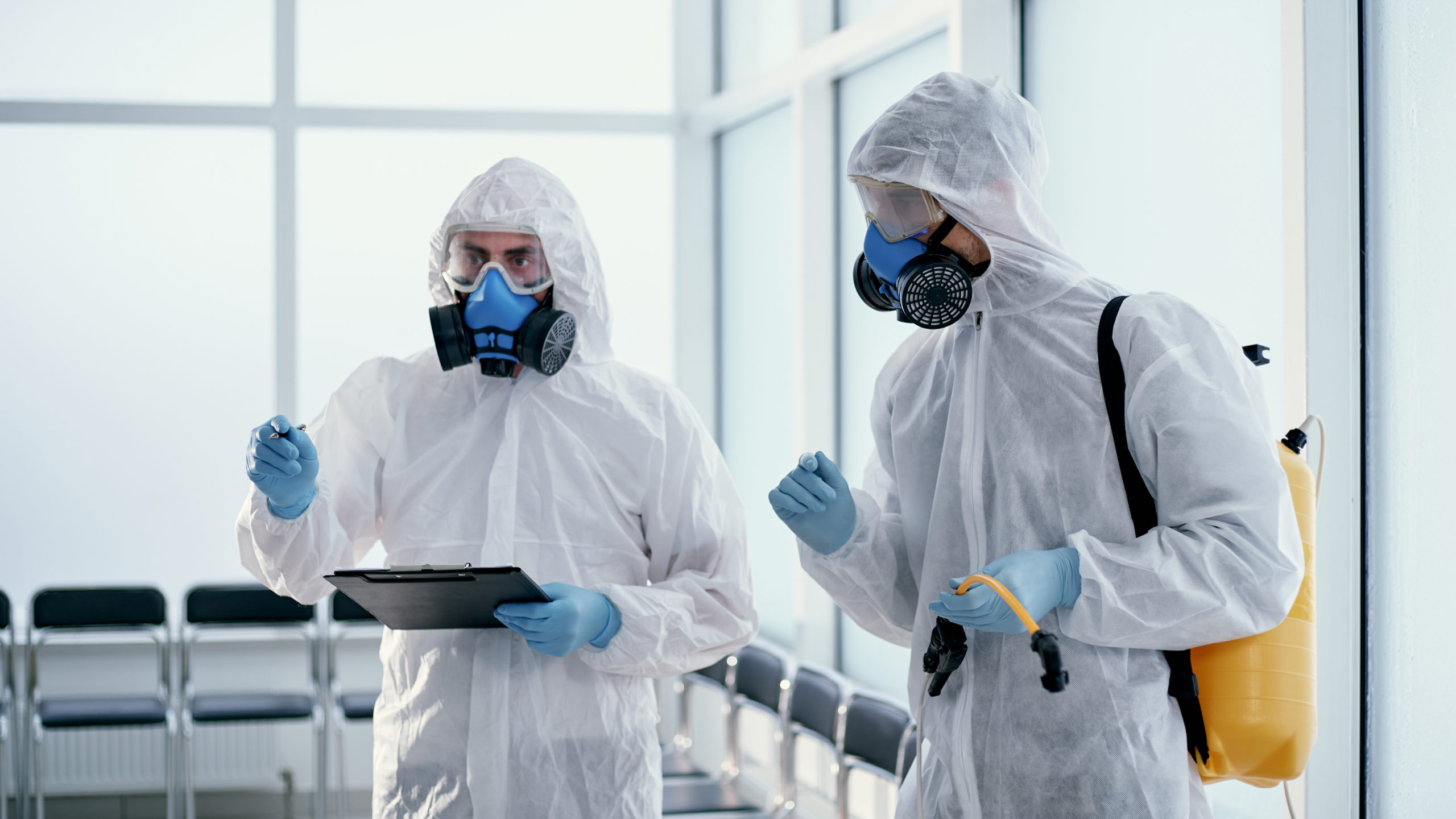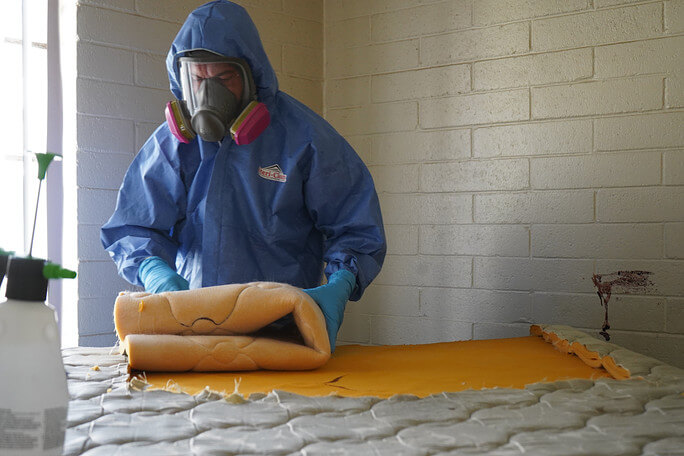Flood Damage Restoration: Quick and Reliable Recovery for Your Home
Flood Damage Restoration: Quick and Reliable Recovery for Your Home
Blog Article
Specialist Biohazard Cleaning and Purification for Blood, Bodily Fluids, and Hazardous Materials
The prospective health risks associated with exposure to biohazards underscore the crucial demand for thorough handling and detailed cleaning. As we navigate the intricate landscape of biohazard cleaning, comprehending the nuances of policies, compliance, and the specialized devices at play becomes vital in guaranteeing a complete and secure purification process.
Health Dangers of Biohazard Exposure
Exposure to biohazards poses significant health threats that can lead to severe repercussions for areas and people alike. Biohazards include a variety of biological materials, consisting of blood, bodily liquids, mold and mildew, bacteria, infections, and various other possibly transmittable products. When people enter call with these biohazards, whether through mishaps, inappropriate handling, or ecological direct exposure, they deal with the risk of having major health problems or illness.
One of the primary wellness threats associated with biohazard direct exposure is the transmission of transmittable diseases. Bloodborne virus such as HIV, hepatitis B and C, and various germs can be present in biohazardous materials, posing a direct danger to human health. Breathing in air-borne biohazards like mold and mildew spores or entering contact with polluted surfaces can additionally result in respiratory system concerns, allergic reactions, and various other adverse health and wellness effects.
In addition, biohazard direct exposure can have long-term health effects, with some diseases showing up years after the first get in touch with (Blood Cleanup). As a result, it is important to prioritize proper biohazard cleansing and decontamination to reduce these health and wellness dangers and make certain the security of individuals and communities

Specialized Educating for Biohazard Cleanup
When it involves taking care of biohazard clean-up efficiently and securely, specialized training plays a fundamental role in making certain proper purification treatments are followed. Biohazard cleaning needs details knowledge and skills to efficiently mitigate risks connected with bloodborne microorganisms, bodily fluids, and dangerous products. Experts trained in biohazard clean-up go through strenuous guideline on just how to securely take care of, eliminate, and dispose of biohazardous materials to stop contamination and direct exposure.
Specialized training for biohazard cleanup covers a series of essential topics, consisting of appropriate personal protective equipment (PPE) usage, bloodborne virus recognition, decontamination methods, and harmful waste disposal procedures. People trained in biohazard cleanup are furnished with the necessary competence to analyze contamination levels, determine possible hazards, and carry out ideal cleaning procedures in conformity with governing requirements.
Continuous training and education are paramount in the area of biohazard cleaning to stay updated on the current decontamination innovations, security methods, and laws. By investing in specialized training, biohazard cleanup specialists can successfully react to emergency cleaning situations and guard both public wellness and the environment.
Value of Appropriate Decontamination Methods
Using proper purification techniques is essential in biohazard cleanup to properly eliminate unsafe materials and minimize health and wellness risks. Reliable decontamination not just makes certain the elimination of visible traces of blood, bodily fluids, and other biohazards yet additionally targets undetectable microorganisms that might position significant health hazards if not appropriately eliminated. By complying with stringent decontamination procedures, educated specialists can substantially lower the threat of exposure to dangerous bacteria, viruses, and germs that could lead to illness or infections.
Appropriate purification techniques entail the usage of specialized equipment and anti-bacterials that are specifically designed to counteract biohazards properly. Complete cleansing and disinfection of infected locations are vital to avoid the spread of pathogens and guarantee a secure atmosphere for owners. In addition, the correct disposal of biohazardous waste adhering to decontamination procedures is vital in stopping contamination of various other surfaces or individuals.

Devices and Devices for Safe Cleanup
The appropriate equipment and tools play a vital role in making sure the efficient and secure cleaning of biohazardous materials. When dealing with blood, physical liquids, or unsafe materials, biohazard cleaning experts count on specialized equipment to decrease exposure dangers and extensively decontaminate the biohazard cleanup price afflicted location. Individual protective equipment (PPE) such as gloves, coveralls, goggles, and masks are vital to shield against straight contact with possibly transmittable materials. Additionally, biohazard cleaning sets consisting of disinfectants, absorbing materials, and biohazard bags are utilized to safely get rid of and consist of of infected products. Blood Cleanup.
Advanced cleaning tools like hospital-grade anti-bacterials, HEPA-filtered vacuum cleaners, and misting equipments are utilized to sanitize surface areas and eliminate biohazards successfully. Specialized devices such as sharps containers and biohazard garbage disposal bins are made use of to securely handle sharp items and biohazardous waste products. By making use of the ideal equipment and devices, biohazard cleaning professionals can guarantee a detailed cleaning process that prioritizes safety and lessens health and wellness dangers for both workers and passengers of the affected space.
Regulations and Compliance in Biohazard Cleaning
Proper adherence to policies and conformity criteria is paramount in biohazard cleansing to make certain the security of both employees and the atmosphere. Government companies such as OSHA (Occupational Security and Health And Wellness Management) and the EPA (Epa) have developed specific guidelines for biohazard clean-up procedures to decrease health and wellness dangers and ecological contamination. These policies cover a variety of aspects consisting of the handling, transportation, and disposal of biohazardous materials, as well as the essential training and safety devices required for workers included in the cleanup procedure.
Biohazard cleaning firms have to stay updated with these laws to assure that their operations satisfy the needed safety and security criteria. Failing to adhere to these regulations can cause serious consequences, including fines, legal activity, and jeopardizing the wellness of people and the setting. By complying with rigorous regulations and compliance steps, biohazard cleaning firms can effectively minimize dangers and make sure a detailed and safe cleaning process for all events entailed.
Conclusion
Finally, biohazard cleansing and decontamination call for customized training, proper methods, and adherence to guidelines. Direct exposure to blood, physical fluids, and harmful products poses considerable wellness risks, making it important to make use of the ideal devices and devices for risk-free cleanup. By following stringent methods and guidelines, experts can efficiently alleviate the risks connected with biohazard exposure and ensure the safety and security of both themselves and others.
As we navigate the complex landscape of biohazard clean-up, recognizing the subtleties of laws, conformity, and the specialized equipment at play comes to be crucial in making certain Clicking Here a complete and safe decontamination process. (Blood Cleanup)
When it comes to taking care of biohazard clean-up effectively and safely, specialized training plays an essential duty in guaranteeing proper decontamination treatments are followed.Using proper purification techniques is critical in biohazard cleanup to properly decrease and eliminate unsafe products helpful resources health risks. Additionally, biohazard cleansing kits containing disinfectants, absorbing products, and biohazard bags are made use of to safely contain and get rid of of contaminated things.
Government firms such as OSHA (Occupational Security and Health And Wellness Administration) and the EPA (Environmental Protection Firm) have established details standards for biohazard cleaning procedures to decrease health risks and ecological contamination.
Report this page